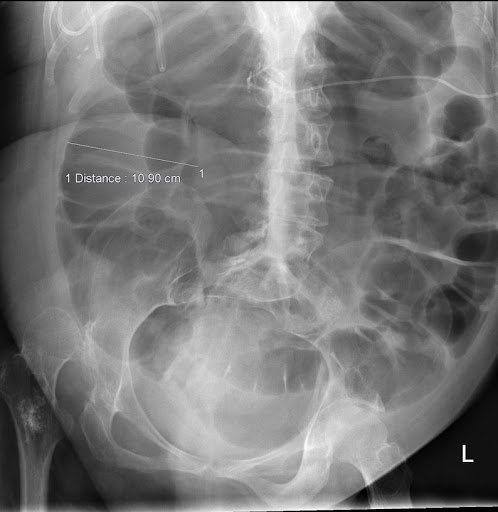Paralytic ileus, also known as functional bowel obstruction, is a temporary cessation of peristalsis in the intestines without any physical blockage. Unlike mechanical obstruction, paralytic ileus disrupts the coordinated muscular contractions required to move contents through the gastrointestinal tract. This condition is frequently observed postoperatively, especially following abdominal or pelvic surgeries, but can also be secondary to a range of systemic disorders and medications.

Causes of Paralytic Ileus
Paralytic ileus may arise from several etiological factors, typically disrupting the neuromuscular function of the gut.
Postoperative Ileus
- Most common cause
- Frequently occurs after abdominal or spinal surgery
- Triggered by handling of the bowel and neuroinflammatory responses
Medication-Induced Ileus
- Opioids (e.g., morphine, fentanyl): Reduce intestinal motility
- Anticholinergics: Inhibit parasympathetic activity
- Calcium channel blockers: Impair smooth muscle contractility
Metabolic and Electrolyte Imbalances
- Hypokalemia
- Hyponatremia
- Hypercalcemia
- Uremia and diabetic ketoacidosis
Infections and Inflammation
- Peritonitis
- Sepsis
- Pneumonia (especially in elderly patients)
- Pancreatitis
Other Contributing Factors
- Trauma or spinal cord injury
- Systemic illness (e.g., hypothyroidism)
- Retroperitoneal hemorrhage
- Use of general anesthesia
Pathophysiology: How Ileus Develops
Paralytic ileus results from a failure of neuromuscular coordination within the intestinal wall, leading to a halt in peristaltic movement. Unlike mechanical obstruction, there is no occlusion of the lumen. The autonomic nervous system, inflammatory mediators, and gut hormones all play a role in suppressing peristalsis.
Clinical Presentation of Paralytic Ileus
Patients with paralytic ileus exhibit signs and symptoms related to intestinal stasis and abdominal distention. These can closely mimic those of a mechanical obstruction but without signs of an anatomical blockage.
Common Symptoms
- Abdominal bloating and distension
- Nausea and vomiting
- Anorexia or inability to tolerate oral intake
- Absence of bowel sounds (or hypoactive sounds)
- Constipation and inability to pass gas
- Mild abdominal discomfort without cramping
Physical Examination Findings
- Tympanic abdomen on percussion
- Reduced or absent bowel sounds
- Mild diffuse tenderness without peritoneal signs
Diagnostic Evaluation
Proper identification of paralytic ileus is essential to differentiate it from mechanical obstruction and guide appropriate treatment.
Imaging Studies
- Abdominal X-ray: Shows dilated bowel loops with air-fluid levels and no transition point
- CT Scan: Rules out mechanical obstruction; may reveal a diffusely dilated bowel without an identifiable blockage
Laboratory Investigations
- Electrolyte panel: Evaluate for hypokalemia or other abnormalities
- CBC and inflammatory markers: Assess for infection or inflammation
- Renal and hepatic panels: Identify metabolic causes
Differential Diagnosis
The clinical features of paralytic ileus may overlap with other gastrointestinal emergencies. Key differentials include:
- Mechanical small bowel obstruction
- Colonic pseudo-obstruction (Ogilvie’s syndrome)
- Mesenteric ischemia
- Toxic megacolon
Management and Treatment of Paralytic Ileus
Effective management involves supportive care, removal of precipitating factors, and cautious reintroduction of gastrointestinal activity.
General Supportive Measures
- Nil per os (NPO): Discontinue oral intake to rest the bowel
- IV fluids: Maintain hydration and correct electrolyte imbalances
- Nasogastric tube: Decompress the stomach in cases of severe distention or vomiting
Pharmacological Intervention
- Prokinetic agents: Metoclopramide or erythromycin may be used selectively
- Avoid opioids: Switch to non-opioid analgesics when possible
- Electrolyte replacement: Prompt correction, especially of potassium
Mobilization
- Early ambulation post-surgery enhances bowel motility and reduces ileus duration
Nutritional Support
- Gradual refeeding: Initiate clear fluids once bowel sounds return and advance diet as tolerated
- Parenteral nutrition: Required in prolonged cases where enteral feeding is not feasible
Prevention of Postoperative Ileus
Preventive strategies are essential to reduce the incidence of ileus in surgical patients.
- Minimize opioid use through multimodal analgesia
- Laparoscopic techniques instead of open surgeries when possible
- Alvimopan: A peripherally acting μ-opioid receptor antagonist used prophylactically in selected high-risk surgeries
- Enhanced Recovery After Surgery (ERAS) protocols
Prognosis and Outcomes
Paralytic ileus is usually self-limiting, resolving within 2–5 days postoperatively. In prolonged or severe cases, especially when underlying systemic illness is present, the condition may persist longer, requiring extended hospitalization and supportive care.
Complications can arise if left unmanaged:
- Aspiration pneumonia
- Electrolyte disturbances
- Malnutrition
- Prolonged hospital stay
Frequently Asked Questions:
How long does paralytic ileus last?
Typically, paralytic ileus resolves within a few days post-surgery, especially with early ambulation and supportive care.
Is paralytic ileus life-threatening?
It is not inherently life-threatening but can lead to serious complications if untreated or associated with severe underlying illness.
What are the first signs of paralytic ileus?
Bloating, abdominal discomfort, nausea, and the absence of bowel movements or sounds are key early indicators.
How is paralytic ileus different from bowel obstruction?
Paralytic ileus is a functional loss of peristalsis without any mechanical blockage, while bowel obstruction involves a physical barrier to passage.
Can paralytic ileus recur?
Yes, especially in patients with repeated surgeries, prolonged opioid use, or chronic illness affecting gut motility.